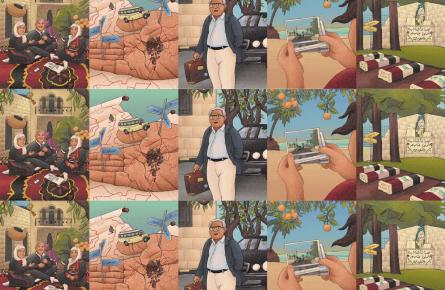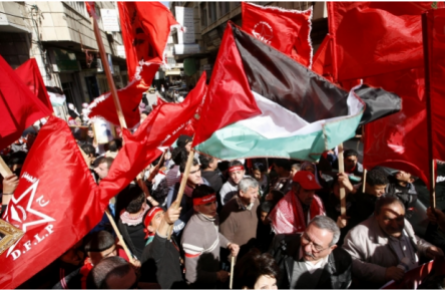Congresswoman Rashida Tlaib (D-Mich.) came under attack this week after she told the Yahoo News podcast “Skullduggery” that she was “humbled by the fact that it was my [Palestinian] ancestors that had to suffer” in order for Israel to be created as a safe haven for Jews in the wake of the Holocaust. Historian Benny Morris accused Tlaib of “misleading her listeners about the early history of the conflict in Palestine,” and CNN anchor John King claimed Tlaib’s remark “revises history.”
While Tlaib certainly simplified a complex history that historians have and will continue to debate, her critics are also fundamentally misreading Palestinian history in three key ways. First, by focusing on episodes of violence, they ignore the long history of Arab-Jewish coexistence in Palestine. Second, by downplaying how harmful British colonial rule was to Palestinian society, they imply that Palestinians were driven to revolt by blind hatred rather than a desire for freedom. Finally, by citing the pro-Nazi propaganda of Mufti Hajj Amin al-Husayni to claim that “Palestinian leaders at the time sided with Hitler,” they conflate the statements and actions of a single individual with those of an entire people.
Throughout the 19th century, Muslims, Christians and Jews lived together in Palestine in relative harmony, largely in cities like Jerusalem, Jaffa, Hebron, Safed and Tiberias. Jewish residents regularly interacted with their Muslim and Christian neighbors, speaking Arabic with one another and living what historian Menachem Klein describes as “lives in common.”
[Current Issues In Depth | Dangerous Conflation: Zionism, Israel, and Anti-Semitism]
At the turn of the 20th century, all three groups held great hopes that revolutionary change in the Ottoman Empire (which ruled over Palestine at the time) would lead to greater freedom and equality. They hoped to become what historian Michelle Campos calls “Ottoman Brothers.”
Inspired by growing nationalism in the region, Palestinian Arabs chafed at the centralizing policies of their Turkish rulers and started to demand greater independence in Palestine.
Ethno-nationalism in Russia and Eastern Europe took shape differently. With violence being waged against Jewish communities there, waves of Zionists (Jewish nationalists) emigrated from Russia to Palestine with aspirations of establishing a homeland of their own. But, as poignantly captured in the PBS documentary, “1913: Seeds of Conflict,” with their slogan of “Hebrew labor, Hebrew land,” they sought to establish sovereignty over Palestine, not live there as one group among many.
With the rise of competing aspirations for the same land, tensions were bound to arise. But the formalization of British colonial rule over Palestine in 1922 made matters much, much worse. The British recognized only Jewish national claims over Palestine, thereby putting Palestinian Arabs in what historian Rashid Khalidi calls“an iron cage.” If Palestinian Arabs recognized British rule over them, they were effectively giving up any hope of true independence. But if they rejected British rule, they would be seen as undeserving of self-rule.
[Current Issues In Depth | UNRWA and Palestine Refugee Rights]
The question of self-rule gained greater urgency over the course of the 1920s as growing Jewish immigration led to thousands of Palestinian peasants being forced off land they had lived on for generations. Many of them migrated to shantytowns on the outskirts of nearby cities, looking for work and often unable to find any. As social and economic pressures increased, Palestinian leaders — who lacked any real power and were divided among themselves — could do little to help.
Exacerbating this situation, in 1921 the British chose Amin al-Husayni, at the time a minor Muslim cleric from a notable family, to be a pliant local leader who would fit into their divide-and-rule strategy. As historian Nicholas Roberts shows, the British bestowed upon Husayni an important-sounding title (Grand Mufti) and created for him an important-sounding institution (the Supreme Muslim Council), neither of which had existed before. The result was that the highest authority for Palestinian Muslims had little popular legitimacy beyond his family’s history of serving as a mediator between imperial powers and the local population.
With mounting social and economic frustrations, Palestinian Arabs turned to mass politics. Some of the first major protests, which took place in Jerusalem and Hebron in 1929, became infamous for the riots that led to the tragic deaths of 116 Arabs and 133 Jews, including 67 Jews who were murdered in Hebron. Yet as Tom Segev points out, Hebron’s Arab residents also saved 435 of their Jewish neighbors. They understood that their conflict was with British colonial rule, not with Jews.
This understanding of their struggle was also central to the young Palestinian Arabs who founded the Istiqlal (Independence) party in 1932. They drew on Gandhian principles of noncooperation to demand independence from the British, just as their counterparts were doing in India. After leading several successful nonviolent demonstrations in fall 1933, the Istiqlal movement was undermined by the British and by the Mufti, whose position was threatened by the rise of a genuinely populist, anti-colonial Palestinian movement.
[From the Journal of Palestine Studies | Shifting Sands: Zionism and American Jewry]
With their displacement continuing unabated, in April 1936 Palestinian Arabs launched a general strike to demand independence. While some local leaders like preacher ‘Izz al-Din al-Qassam had called for attacks against British and Jewish targets, as historian Matthew Kraig Kelly has recently demonstrated, the Palestinian leadership (including the Mufti) initially tried to keep the strike unarmed. But widespread British police brutality soon led to an uptick in Arab violence, culminating in a revolt that lasted three years.
The revolt marked a turning point in the Mufti’s relationship with the British. Lacking alternative leadership, Palestinian Arabs turned to the Mufti to lead the strike. He accepted, hoping to stay ahead of rapidly changing developments. But Britain’s wanton violence against the Arabs radicalized the Mufti, leading him to reject his onetime masters. In 1937 he fled to Lebanon to escape arrest, where he helped lead the revolt until it was crushed in 1939.
That year also marked a turning point in the relationship between the British and the Zionists. In a dramatic shift from previous policy, the British White Paper of 1939 placed strict quotas on Jewish immigration to Palestine. For those who saw Palestine as the only escape from the growing Nazi targeting of European Jews, the timing could not have been worse.
The Mufti then became a prominent Nazi propagandist, becoming well known for his World War II broadcasts that called on Arabs to revolt against the British. And yet, these calls were largely ignored. In fact, recent studies have demonstrated that Arabs in Palestine were not generally pro-Nazi, and many were extremely critical of fascism, despite the Mufti’s loathsome exhortations. They were joined by a group of leftists, secular, anti-colonial Arab intellectuals who also vehemently opposed the Mufti’s anti-Jewish rhetoric, calling instead for class solidarity and Arab-Jewish cooperation.
[From the Journal of Palestine Studies | An Immoral Dilemma: The Trap of Zionist Propaganda]
After the war, as the full horrors of the Holocaust became known, and as Zionist militias attacked the British over the latter’s immigration restrictions, the “question of Palestine” was handed over to the newly formed United Nations.
In November 1947 they proposed splitting Palestine into a Jewish state and an Arab state. This “Partition Plan” would have forced half a million Palestinian Arabs to make a stark choice: live as a minority within a Jewish state, or leave their homeland. This reality helps explain Palestinian opposition to the creation of a Jewish state.
Fighting between Arabs and Jews in Palestine broke out the day after the Partition Plan was announced. While the local Arabs sought to prevent its implementation, Zionist militias sought to establish their rule — by force if necessary — over the areas slated as part of the Jewish state. As a result of those battles, and the subsequent Arab-Israeli war that broke out on May 15, 1948, over half of the 1.3 million Arabs living in Palestine fled or were forcibly removed from their homeland. Most of them and their descendants remain refugees today. Every year on May 15, Palestinians mark this catastrophe (“Nakba” in Arabic), but they also commemorate their ongoing connection to their homeland.
As we commemorate the 71st anniversary of the Nakba this week, let’s take seriously Palestine’s well-documented history of Arab-Jewish coexistence and Palestinians’ long-standing struggle for freedom and justice. While Rashida Tlaib’s characterization omitted this complicated backstory — one in which there was plenty of fault to go around — she was not wrong that her ancestors suffered as part of the process that eventually led to the creation of Israel as a Jewish safe haven. If we actually wish to solve the Palestinian-Israeli crisis, we must learn to listen to both sides and understand the complexity of this history.
This article first appeared in the Washington Post.




